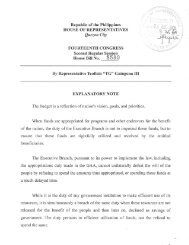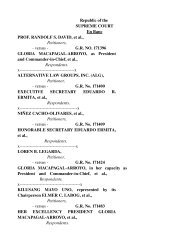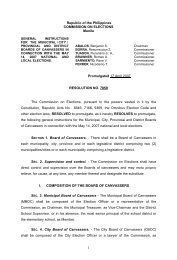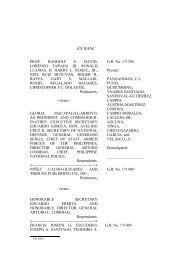i Report Issue No. 3 2005 - Philippine Center for Investigative ...
i Report Issue No. 3 2005 - Philippine Center for Investigative ...
i Report Issue No. 3 2005 - Philippine Center for Investigative ...
Create successful ePaper yourself
Turn your PDF publications into a flip-book with our unique Google optimized e-Paper software.
T H E L O S T G E N E R A T I O N<br />
Watson’s store displays shelves<br />
upon shelves of skin whitening<br />
products. Most companies now<br />
include a whitening component<br />
in their entire product line, from<br />
soaps and moisturizers to toners<br />
and sunblocks and creams.<br />
Having fair skin, though, is not<br />
enough to be called a real beauty<br />
these days, at least based on the<br />
nonstop ads. At any given time<br />
of the day—and night—there is<br />
bound to be a shampoo commercial<br />
extolling the virtues of<br />
having long, shiny tresses. Once<br />
primetime hits, suds and bubbles<br />
practically spill out of the TV sets<br />
with all the hairwashing going on.<br />
On ABS-CBN between 6:00-<br />
6:30 pm, a shampoo commercial<br />
comes on air like clockwork.<br />
“Bounce!” it exhorts, “Freshness!<br />
Bounce!” while yet another<br />
mestiza model sashays around<br />
a basketball court bouncing her<br />
hair all over the place. Fifteen<br />
minutes later, there’s another<br />
shampoo ad, this time done like<br />
a bad MTV video with an inanely<br />
catchy refrain, dancing girls and<br />
a storyline that goes, girl wants<br />
boy, boy snubs girl because she is<br />
bruha-looking<br />
, girl uses shampoo,<br />
boy falls in love with girl, and<br />
they live happily ever—or until<br />
she stops using the shampoo. The<br />
commercial seems to last five long<br />
minutes. The tagline: instant ayos,<br />
parang magic<br />
talaga, kinamay<br />
lang inayos na (perfect hair<br />
instantly, just like magic, just with<br />
the fingers).<br />
A confused confession:<br />
I use that brand but my hair<br />
doesn’t ayos in a similar manner,<br />
instantly or even after I tug at it<br />
with my fingers <strong>for</strong> an hour. I still<br />
need to use a brush or a comb. I<br />
concede an advertiser’s creative<br />
and artistic license, and the small<br />
print does say “results may vary.”<br />
But I’d like to do a real-life test<br />
and see if any girl can attain a<br />
perfectly straight, perfectly shiny<br />
‘do just by running her fingers<br />
perfunctorily through her hair.<br />
ALA PAREDES, 22, host of<br />
IslaMusik on ABC5, as well as<br />
writer and model, is the proud<br />
owner of a crown of curls. She<br />
finds the current crop of haircare<br />
and skincare commercials<br />
“abominable” because they<br />
don’t promote uniqueness or<br />
diversity. “Instead of celebrating<br />
physical differences,” she<br />
says, “they make people think<br />
you have to look a certain way<br />
to be beautiful.”<br />
She should know. In an<br />
industry that prizes fair skin and<br />
straight hair, her morena skin<br />
color and loose, voluptuous<br />
curls are considered unconventional.<br />
This demand <strong>for</strong> an<br />
“ideal” look has cost her jobs,<br />
she believes, because casting<br />
people who deviate from the<br />
norm is risky. To think she already<br />
has a perceived edge, being<br />
the daughter of Jim Paredes<br />
of APO Hiking Society fame.<br />
People who look “different”<br />
are usually given character<br />
roles, while the lead goes to a<br />
fair, straight-haired girl. Curly<br />
hair may look gorgeous on Jericho<br />
Rosales but put the same<br />
mop on some girl’s head and<br />
there will be people thinking<br />
she could be Valentina’s longlost<br />
sister. Curly hair is often<br />
associated with messiness or<br />
wildness while straight hair is<br />
more malinis or neat to look at.<br />
Similarly, when it comes to skin<br />
color, white is associated with<br />
cleanliness and purity.<br />
Of course one can argue<br />
hair and skin color is a matter of<br />
preference. But you will almost<br />
never hear a person say about<br />
an actress or model, “I don’t like<br />
her because she has straight hair”<br />
or “Yuck, look at her, ang puti<br />
niya (she’s so fair)”—unless we<br />
are talking Sadako-white (then<br />
again, she was more on the gray<br />
shades). Obviously, says Paredes,<br />
a norm has been set.<br />
Some companies are not<br />
even above using blatantly<br />
discriminatory or politically<br />
incorrect methods to sell their<br />
products. Paredes cites a whitening<br />
product ad where a mestiza<br />
couple is having their baby<br />
baptized. The priest smiles at<br />
the couple but when he pulls<br />
the baby’s blanket back, he<br />
looks aghast. The camera then<br />
zooms in on the baby who has<br />
dark skin, and then zooms out<br />
to show the mother’s relatives<br />
having brown skin. Translation:<br />
mommy used the product. Says<br />
Paredes: “I felt they were presenting<br />
the baby in a ridiculous<br />
manner. The majority of Filipinos<br />
have dark skin, including<br />
me. I felt personally offended.”<br />
She’s not the only one. From<br />
talking to my young cousins and<br />
their friends, there seems to be a<br />
consensus that the marketing of<br />
these skin-whitening products is<br />
vaguely disturbing and occasionally<br />
offensive on some level. It<br />
raises many questions. What is<br />
wrong with our skin color? Why<br />
are we trying to look different<br />
from what we are?<br />
UNCONVENTIONAL<br />
LOOKS. Model<br />
Ala Paredes has<br />
curly hair in a<br />
country where long,<br />
straight hair(left)<br />
is considered the<br />
epitome of female<br />
beauty.<br />
TO ME the culprit is the plethora<br />
of advertisers imposing a lanky<br />
model with abnormally bouncy<br />
hair and porcelain-white skin on<br />
us hapless mortals. But Art Ilano<br />
disagrees. He says advertising<br />
isn’t really to blame <strong>for</strong> our seeming<br />
fixation with straight hair and<br />
white skin. According to him, “it’s<br />
ingrained in our culture.”<br />
Ilano argues that advertisers<br />
only ride trends; they don’t create<br />
them. “Someone somewhere tried<br />
skin whitening and saw there is<br />
a market <strong>for</strong> it,” he says. “Papaya<br />
soap used to be a niche market<br />
with no budget <strong>for</strong> advertising but<br />
people liked it. It had strong sales<br />
in the provinces. That’s when<br />
ads come in.” Advertising only<br />
does the market research. It does<br />
not trans<strong>for</strong>m people’s opinions<br />
but it serves to accelerate trends.<br />
“Besides,” Ilano adds, “marketers<br />
aren’t that creative.”<br />
Well, neither is the popularity<br />
of skin-whitening products caused<br />
by colonial mentality alone. Other<br />
countries like Korea or Japan<br />
which haven’t been colonies of<br />
Western powers also go ga-ga<br />
over whitening products. So if<br />
“culture” is to blame, that may really<br />
mean our Asian culture.<br />
As <strong>for</strong> long, straight hair, there<br />
used to be a time when this was<br />
associated with those who came<br />
straight from the provinces, or<br />
people who wanted to look “ethnic”<br />
or had ambitions of marrying<br />
<strong>for</strong>eigners (hence the phrase “export<br />
beauties”; <strong>for</strong> some reason,<br />
most Western men seem to pick<br />
women with long hair whenever<br />
they go hunting <strong>for</strong> a partner in<br />
Asia). Once upon a time, the<br />
mark of a mestiza was a head<br />
of wavy locks. It was the indios<br />
or natives who had straight hair.<br />
Actually, either that or kinky<br />
hair. Anyway, all these make it<br />
hard to argue that culture led to<br />
our present obsession with long,<br />
straight hair.<br />
But maybe it’s not a matter<br />
of culture vs. advertising.<br />
For all we know, they could<br />
be mutually feeding on each<br />
other. Un<strong>for</strong>tunately, we’re<br />
stuck with just the obvious: a<br />
constant assault of images and<br />
products promoting only one<br />
type of beauty and leaving little<br />
room <strong>for</strong> diversity. (Where<br />
is Benetton when you need it?)<br />
Yet despite the double-digit<br />
growth of skin whiteners and<br />
the prevalence of shiny, longhaired<br />
artistas<br />
in the country,<br />
many teens are aware, at least<br />
in theory, that beauty comes in<br />
many shapes, colors, and sizes.<br />
Sometimes, a company<br />
comes along believing that, too.<br />
In 2003 the local girls’ clothing<br />
line Bayo launched Kat Alano in<br />
its “A Girl Like You” campaign.<br />
An EDSA billboard depicted a<br />
pretty girl with a mop of curls.<br />
The emphasis was on being different.<br />
The campaign was a great<br />
success and today Kat Alano’s<br />
career is thriving. Perhaps this<br />
means that young Filipinas, as<br />
personal care consumers, are<br />
open, if not eager, <strong>for</strong> different<br />
types of beauty on our billboards<br />
and television screens.<br />
<strong>No</strong>w if only more advertisers<br />
and marketers become a little bit<br />
more creative and take note.<br />
Cheryl Chan was an intern at the PCIJ<br />
and is currently pursuing a master’s<br />
in journalism at the University of<br />
British Columbia. She shakes her fist<br />
at the television every time a shampoo<br />
commercial comes on.<br />
PHILIPPINE CENTER FOR INVESTIGATIVE JOURNALISM<br />
I REPORT<br />
47

















